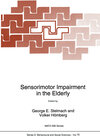
×
![Buchcover ISBN 9789401048729]()
Inhaltsverzeichnis
- Section 1: Sensorimotor Integration.
- Nordic comparison of 75-year-olds -- sensory and psychomotor functions.
- Motor performance as a paradigm reflecting the aging process.
- Decline of psychomotor performance: calender or health?.
- The influence of aging on motor skill learning.
- The decline of spatial and temporal abilities with age.
- Age-related slowing.
- Aging and plasticity of the human motor system: evidence from positron emission tomography (PET).
- Section 2: Age Changes in Muscle.
- Myoelectric signs of muscle fatigue and physiological tremor from childhood to seniority.
- Muscle force generation and age: the role of sex hormones.
- What is the cause of the ageing atrophy? Assessment of the fiber type composition in whole human muscles.
- Section 3: Posture and Locomotion.
- Cognitive processes involved for maintaining postural stability while standing and walking.
- Mobility biomechanics in young and old healthy adults.
- Postural control in normal subjects and older women who have fallen.
- Postural responses of the elderly: comparisons with vestibular- deficit subjects.
- Modulations of gait in normal aging and in parkinson’s disease.
- Age-related changes in visually guided locomotion over different terrains: major issues.
- Optical flow as a factor in falling: the case for more research.
- Section 4: Neurological Diseases.
- Motor slowness in parkinson’s disease.
- Timing in perceptual and motor tasks in parkinson’s disease.
- Signal-to-noise ratio of handwriting size, force, and time: Cues to early markers of parkinson’s disease?.
- Procedural memory, motor skill and degenerative neurological disease.
- Effect of age, chronic diseases and parkinsonism on postural control.
- Section 5: Effects of Training.
- Improvements in balance in the elderly through training insensory organization abilities.
- Age and practice effects on force control of the thumb and index fingers in precision pinching and bilateral coordination.
- Sensorimotor adaptability in the elderly and disabled.
- Years of physical activity can affect simple and complex cognitive/motor speed in older adults.
- Author Index.




